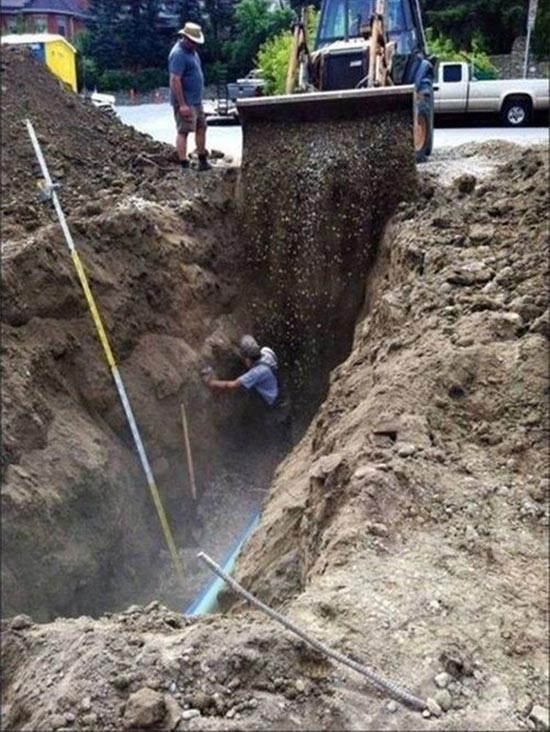Gravedigger Engulfed In Cave-in of Unguarded Grave
 “A Trench is a Trench is a Trench”
“A Trench is a Trench is a Trench”
An employee of a cemetery in Farmingdale, New York, was seriously injured on May 7, 2015, when the walls of the grave opening in which he was working collapsed and buried him up to his waist.
An inspection by the Long Island Area Office of the U.S. Department of Labor’s Occupational Safety and Health Administration found that the excavation and its support systems lacked adequate protection against cave-ins and the excavation had not been inspected to identify such deficiencies. Other hazards included damaged equipment and the placement of excavated soil on the edge of the unprotected trench. These conditions exposed employees to the hazards of cave-in, engulfment and struck-by injuries.
This worker literally came close to an early grave because the cemetery failed to provide proper excavation protections.
“This cave-in could have been prevented if proper and legally required trenching safety procedures had been followed by the employer,” said Anthony Ciuffo, OSHA’s Long island (NY) area director. “It is imperative that cemeteries ensure that workers at all its cemeteries are protected against cave-in hazards and ensure that an incident such as this does not happen again in the future.”
OSHA cited the company on Nov. 5, 2015, for two willful and three serious violations of workplace safety standards.
Roco Comments from Dennis O’Connell, Director of Training:
You may think of this is an unusual circumstance, a once in a lifetime event. Sorry, but you’re wrong. During my tenure as a rescuer in NYC, I responded to a number of these jobs, and they present some additional hazards that are not associated with most trench rescue jobs.
You can call it what you want, but a grave is a trench. And the location can make a big difference in terms of hazards presented. For example, I have a house in NY and one in Louisiana – in South Louisiana, we try to bury people above ground, if possible! However, in places like NY, cemetery space is so limited. It’s like high-rises in the city, our cemetery family plots bury multiple family members usually 3 on top of the other, which is referred to as a triple depth grave. This pushes the grave depth to about 8 feet for the first entombment.
So, no matter what you call it – a trench is a trench, and we need to follow OSHA 1926.651-652 requirements for protecting workers. Let’s look at some of the grave/trench basics before we move on to the specific grave hazard. If we dig an excavation that is longer than it is wide, it is a considered a trench – if it is 4’ or deeper, you need to have a ladder or other means of egress for workers; if it is 5’ or deeper, you need to install a protective system.
You must have a Competent Person, as defined by OSHA, to determine what system is adequate and that it is installed properly. They must also inspect the trench and surrounding area for hazards before workers can enter the trench. Of course, there’s a lot more to digging a trench and the responsibilities of the competent person but you get the idea.
Also, just because a trench is only 7’ long and 3’ wide, this does not change the rules or responsibilities associated with digging a trench. If you’re digging a trench, you need to have that competent person; you need to understand the requirements of 1926.651-652; and you need to know who will respond if you have a trench emergency. Keep in mind, most municipal departments, especially volunteer departments, do not have the training or equipment to respond to a trench collapse.
Ok, the added hazard to a grave collapse rescue is the headstone at the end of the grave – depending on the size, they can weigh over 1,000lbs. If it has fallen in the grave on top of the victim, then you will need to use technical rescue techniques and equipment to lift and free the victim. If it is still on the edge, you will need to support, stabilize or remove it before rescuers can work under it. So, even an innocent grave, can be the scene of a complicated technical trench rescue.
Bottom line… if you are digging trenches for whatever reason, or you have contractors digging trenches on your property, you need to be aware of the requirements of 1926.651-652, have a “competent person,” and identify who you are going to call if a collapse happens.
FYI, you need to have 2.9 feet of soil above the casket top. Some say that it’s a public health law. Between you and me, I think it’s to keep Zombies from escaping!
Here is an OSHA fact sheet to help you better understand some of the requirements. OSHA Fact Sheet - Trenching and Excavation Safety

 “A Trench is a Trench is a Trench”
“A Trench is a Trench is a Trench”


